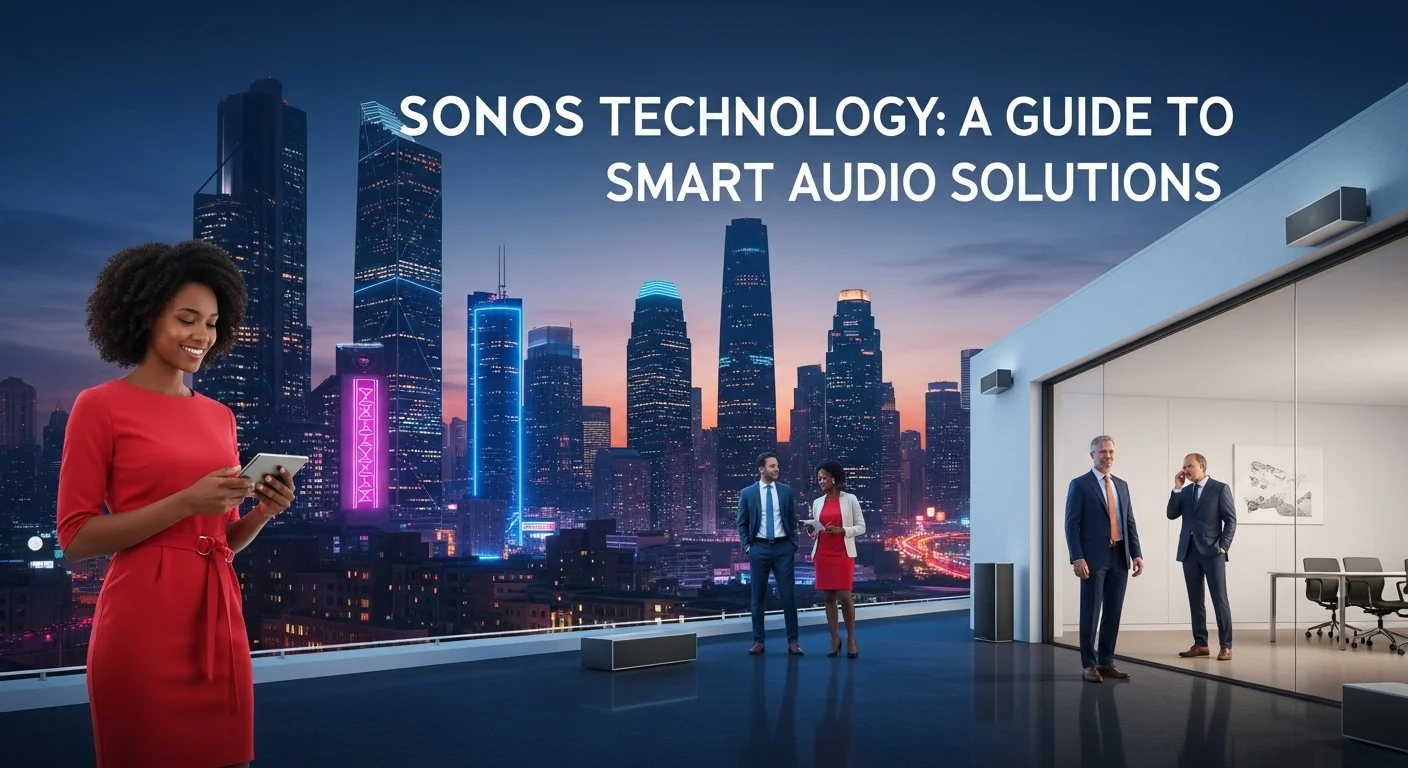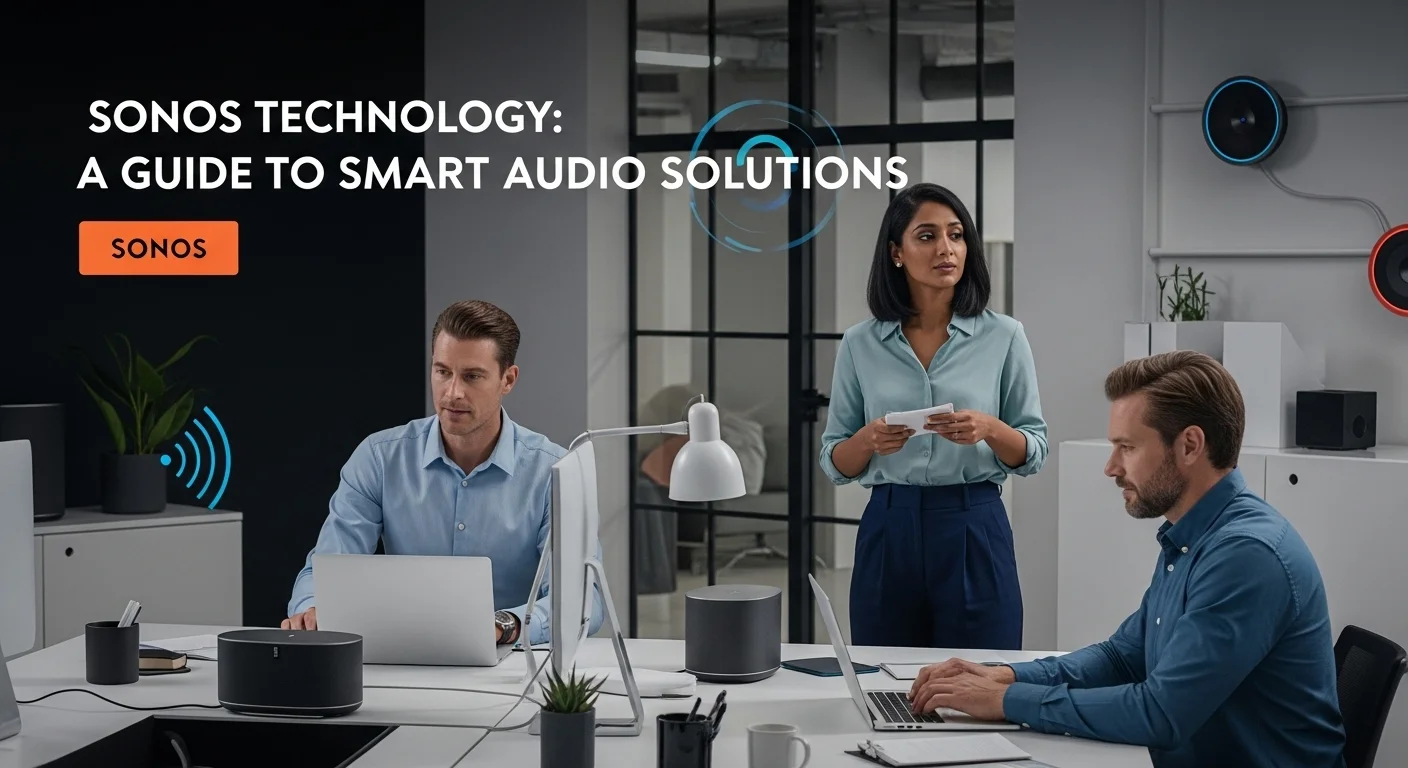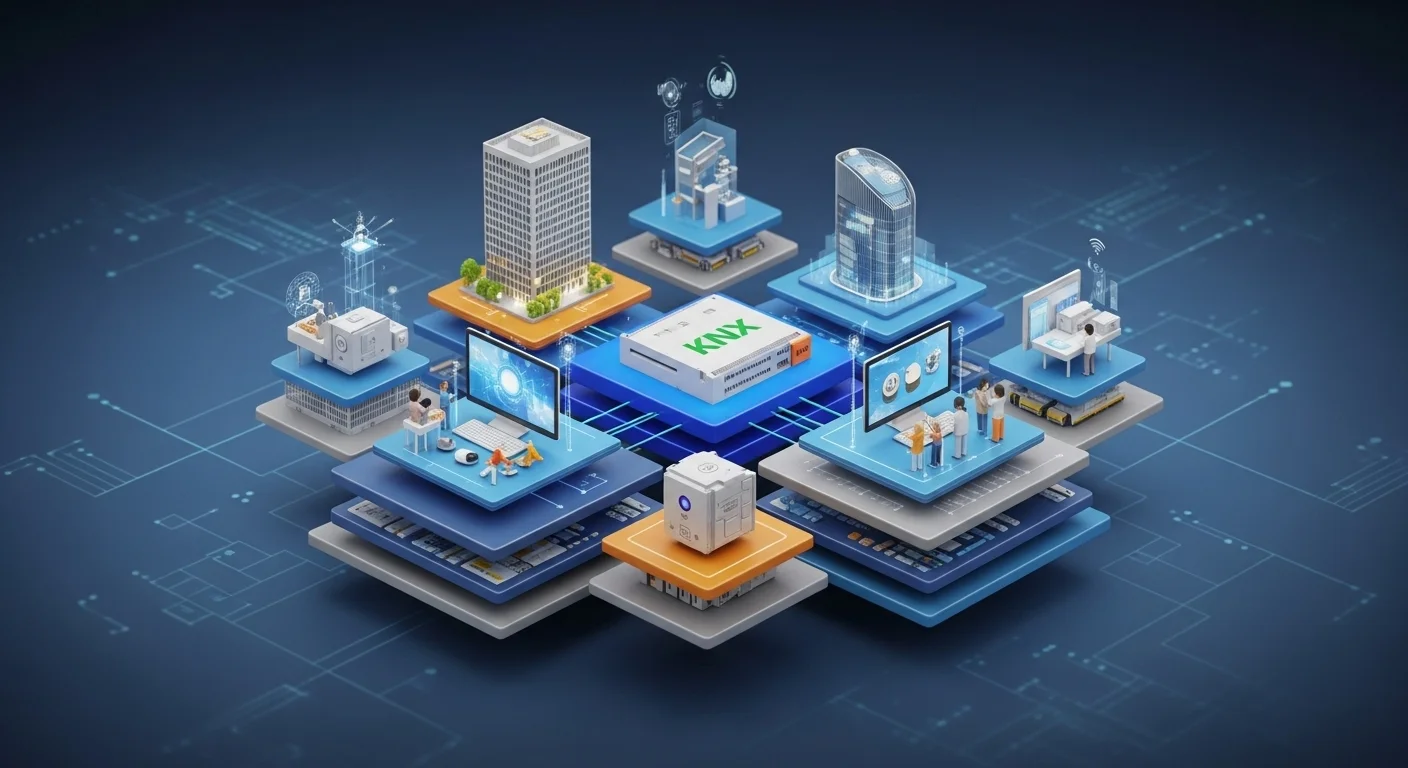Sonos Explained: Your Ultimate Guide to a Smarter Home and Business Audio

Executive Summary
I've been working with smart home tech for over a decade, and I still remember the first time I set up a Sonos system. It was a game-changer. What used to be a mess of wires and complex receivers became a simple, elegant solution that just worked. But Sonos is so much more than just a great speaker. It's a powerful technology platform that can completely transform how you experience audio, both at home and in your business. In this guide, I'll share my hands-on experience and walk you through everything. We'll start with the basics, then dive into how to integrate Sonos with your smart home using platforms like Home Assistant and Apple HomeKit. I'll even show you how businesses can leverage Sonos to create the perfect atmosphere. This is the guide I wish I had when I started.
Table of Contents
Table of Contents
- What is Sonos? The Revolution in Wireless Audio
- The Magic Behind the Music: Sonos' Core Technology
- Sonos in Your Smart Home: Simple Integration
- Unlocking True Power: Advanced Sonos Automation
What is Sonos? The Revolution in Wireless Audio
In the world of technology, some brands just change the game. For home audio, that brand is Sonos. I remember back in the early 2000s, setting up a multi-room audio system for a client was a massive job involving drilling walls and running bundles of speaker wire. It was expensive and inflexible. Then Sonos came along in 2002 with a radical idea: what if you could stream any music, in any room, wirelessly? [32, 33] This wasn't just about getting rid of wires; it was about building an entirely new experience around software and simplicity. Today, Sonos isn't just a speaker company; it's a technology leader whose influence is felt in smart homes and businesses everywhere. Its success story is a masterclass in how to build a beloved tech ecosystem. [32]
The Magic Behind the Music: Sonos' Core Technology
So, how did they pull it off? The secret sauce was a clever mix of great hardware and even better software. Early on, they created something called SonosNet, which was their own private wireless network. [9, 39] Think of it like a dedicated superhighway for your music, separate from your regular Wi-Fi that's busy with laptops, phones, and Netflix. Each speaker on SonosNet could talk to the others, passing the signal along, which created an incredibly stable and reliable system. [39] This is why you rarely get those annoying dropouts with Sonos. While their new speakers work perfectly fine on a standard Wi-Fi network now, that core principle of reliability is still what makes people trust the brand. [1]
But the real genius of Sonos has always been its software-first mindset. The speakers are just the beautiful hardware that delivers the experience. The Sonos app is the brain of the operation, bringing together all your music services—Spotify, Apple Music, you name it—into one clean, easy-to-use place. [9, 32] They made a smart decision not to force you into their own music service. Instead, they became the friendly hub for everything you already listen to. This open approach is why so many people love it. Plus, they constantly push out software updates, so the speaker you bought five years ago keeps getting smarter with new features like voice control or better sound formats.
Sonos in Your Smart Home: Simple Integration
The moment Sonos truly became a cornerstone of the modern smart home was when they added microphones and support for Amazon Alexa and Google Assistant. [32] Suddenly, your speaker wasn't just for listening; it was for controlling. This is where integrating Sonos into your smart home becomes so exciting. You can ask your Sonos Beam to not only play your favorite podcast but also to dim your smart lights and turn up the thermostat. It becomes the central command post for your home, blending high-quality audio with practical, everyday control. For many of my clients, their Sonos speaker is the first and primary way they interact with their entire smart home.
Unlocking True Power: Advanced Sonos Automation
This integration opens up a whole world of possibilities for automating your Sonos system to make your home feel truly intelligent. Through the Alexa or Google Home apps, you can set up simple routines. For example, I have a 'Good Morning' routine that gently fades in a morning playlist on my kitchen speaker, raises my blinds, and gets the coffee brewing. It’s a simple thing, but it makes my morning routine so much more pleasant.
But for those of us who like to tinker, the real fun begins with platforms like Home Assistant and Apple's HomeKit. With Home Assistant, your Sonos automations can become incredibly detailed. Home Assistant is a fantastic open-source tool that lets you connect almost any smart device you can think of. [2] After integrating Sonos, you could create an automation that says, 'If my security camera detects motion on the porch after midnight, play a loud barking sound on the living room speaker.' I've set up systems for clients where a 'Movie Night' scene groups the surround sound speakers, sets the perfect volume, and dims the Philips Hue lights to a warm glow, all with one button press. [18] That's the kind of powerful, customized experience we're talking about.
For those deep in the Apple ecosystem, achieving a seamless experience is also possible. While Sonos speakers work with Apple's AirPlay 2, you can unlock deeper HomeKit automations for your Sonos using a tool called Homebridge. [1, 3, 45] Homebridge is a lightweight server that essentially translates for devices that don't speak HomeKit's language. [21] By adding a Sonos plugin to Homebridge, your speakers appear right in the Apple Home app. [3] This means you can use Siri to control them, add them to scenes, and trigger them with any HomeKit sensor. Imagine creating a 'Goodbye' scene that, when you leave the house, locks the door, turns off all the lights, and pauses the music on every Sonos speaker. It's this level of seamless integration that makes a smart home feel truly magical.
In the business world, Sonos brings that same reliability and ease of use to places like cafes, retail stores, and offices. It provides a scalable, high-quality audio solution that just works. [15] A shop owner can control the music across different zones from their phone, creating the perfect vibe for customers. [4] Through the 'Sonos for Business' service, they can even get licensed music and manage multiple locations from a central dashboard. [15] I've seen firsthand how the right background music can improve a customer's mood and even how long they stay in a store. It's a powerful business tool, and Sonos makes it accessible to everyone.

My Complete Guide to Sonos in Your Home and Business
Alright, let's roll up our sleeves. Owning Sonos is great, but making it the intelligent heart of your space is where the real magic happens. Here's my complete guide, based on years of setting these systems up, on how to transform your Sonos speakers into a truly integrated solution for your home or business.
The first step for most people is connecting Sonos with a voice assistant like Amazon Alexa or Google Assistant. [32] It's incredibly straightforward—you just link your accounts in the Sonos S2 app. Once you do, your Sonos One or Beam doesn't just play music on command; it becomes a full-fledged smart assistant. This is key: it's a two-way street. You can tell Sonos what to play, and you can also tell it to control your other smart devices. In a business setting, a manager in the stockroom can use the Sonos speaker to play music for the customers out front, and in the next breath, ask it to turn on the 'Open' sign and check the security camera feed. The Alexa and Google Home apps are where you'll build 'Routines'—simple automations like 'Hey Google, I'm home,' which can turn on lights, adjust the heat, and start your favorite playlist on Sonos.
Want to go further and truly automate your Sonos system? A great tool I often recommend for beginners is IFTTT (If This Then That). It uses simple 'Applets' to connect services. For instance, I set up an Applet for a client that connected their Google Calendar to Sonos. Whenever an event named 'Time to Focus' started, it would automatically play their 'Deep Work' playlist on their office speaker. For a small shop, you could even have it play a little cash register sound every time you make a sale on your Square POS. It's fun and simple, though for more complex logic, you'll want to step up to something more powerful.
This brings us to my favorite playground: Home Assistant. For any tech enthusiast, using Home Assistant for your Sonos automation is the ultimate goal. It's a free, open-source platform you run yourself (on a small computer like a Raspberry Pi), giving you total control and privacy. [2] Its Sonos integration is phenomenal; it finds all your speakers and gives you deep control over every aspect—grouping, volume, what's playing, you name it. [2, 10] The automation engine is where it truly shines. I once designed a home automation with Sonos for a family that did this: when their smart lock detected the kids were home from school on a weekday, it would group the kitchen and playroom speakers, set the volume to a 'reasonable' 30%, and start a family-friendly playlist. That's the kind of personalized logic you just can't get anywhere else. For businesses, the possibilities are endless—I've seen it used to link Sonos to CO2 sensors in meeting rooms, automatically playing calming music when levels get high to signal it's time for a break. [18]
If you're an Apple household, the dream is full HomeKit automation with your Sonos. While AirPlay 2 is great for basic Siri control, the real power is unlocked with Homebridge. [1, 3, 45] Think of Homebridge as a friendly translator that helps your Sonos speakers talk to Apple HomeKit. [21] By installing a plugin like 'homebridge-zp', all your Sonos speakers pop up in the Home app as if they were native Apple products. [3, 49] They can be represented as switches (on/off for play/pause) or even lightbulbs (brightness for volume). [49] This trick allows you to use the powerful automation tools right inside the Home app. For example, I have a 'Movie Night' scene in my Home app that, with one tap, dims my lights, closes the blinds, and sets my Sonos Arc soundbar to the correct TV input. It’s the most seamless Sonos home automation experience for anyone living in the Apple world. [36]
A Quick Look at My Go-To Automation Methods:
Here’s how I break it down for my clients:
- Voice Assistants (Alexa/Google): The Upside: Super easy, no extra cost, great for simple daily routines. The Downside: Your commands go to the cloud, and the logic is pretty basic.
- IFTTT: The Upside: Very user-friendly, connects to lots of web services. The Downside: Can have a slight delay, and you'll need a subscription for more complex setups.
- Home Assistant: The Upside: The most powerful option by far. It's private, fast, and the community support is incredible. [2] The Downside: It's a hobby! It requires some setup and a dedicated device to run on.
- Homebridge for HomeKit: The Upside: The perfect choice for Apple users. You get full Siri and Home app control. [3] The Downside: Like Home Assistant, it needs a dedicated device and relies on community plugins. [21]
For businesses looking for a professional-grade solution, the 'Sonos for Business' subscription is a great start. It handles all the music licensing headaches and gives you access to a ton of brand-safe stations. [15] But for truly custom applications, like a hotel that wants to greet guests with a personal message in their room, Sonos works with certified integration partners who use their API. These are the pros who can hardwire a system for perfect reliability and connect it to other business software, turning a great sound system into a core part of the customer experience.

My Pro Tips for Getting the Most Out of Your Sonos System
After installing hundreds of Sonos systems, I've learned that a few key strategies can take your experience from pretty good to absolutely amazing. Whether you're a casual user or a business owner, these are my go-to tips for making sure you're getting every bit of value from your investment.
First, Get the Foundation Right: Network and Placement
I know it's not the exciting part, but your network is everything. A flawless Sonos experience starts with a strong network foundation. If you have a large home or a lot of Wi-Fi devices, I strongly recommend wiring at least one of your Sonos speakers directly to your router with an Ethernet cable. [1] This one simple step activates SonosNet, their dedicated mesh network, which is often far more reliable than your home's crowded Wi-Fi. For businesses, I always advise wiring every speaker you can—it's the gold standard for bulletproof performance. Also, a quick tip: keep your speakers off of large metal shelves and out of enclosed cabinets. It really does make a difference for the wireless signal. [11]
Next, don't skip Trueplay tuning! It's a feature in the Sonos app that uses your iPhone or iPad's microphone to listen to your room's acoustics and adjust the speaker's sound. [13, 27] I once had a client with a beautiful living room with high ceilings and lots of glass, and their new speaker sounded thin and echoey. We spent five minutes walking around with Trueplay, and the difference was night and day. It's easily the biggest free upgrade you can give your system. And for home theater, make sure your surround speakers are actually behind you and roughly at ear level when you're seated. It's essential for that immersive feeling. [11]
Advanced Strategies for Power Users
Once the basics are solid, it's time for the fun stuff. If you have two of the same Sonos speakers (like two Era 100s), create a stereo pair. [1, 13] The wide, detailed soundstage you get is so much more engaging than a single speaker. And if you're a vinyl lover like me, getting a speaker with a line-in port, like the Sonos Five, is a must. You can plug in your turntable and stream that warm, crackly sound to every single room in your house. [1]
When you start building automations, my best advice is to think in 'scenes,' not just single commands. Don't just program the speaker to play music; create a 'Focus Mode' scene that plays an ambient playlist, sets your lights to a cool white, and silences your phone notifications. This makes the tech feel more integrated into your life. In Home Assistant, there's a killer feature I use all the time: snapshot and restore. Before I have the system make an announcement, like 'The garage door is open,' I take a 'snapshot' of what the speaker was playing. After the announcement, I 'restore' it, and the music or podcast picks up right where it left off. It's a small detail that makes your home automation with Sonos feel incredibly professional. [18]
For my Apple-using friends, the strategy for HomeKit Sonos automation is all about organization within the Home app. [3] Make sure you assign each speaker to the correct room. This lets you use natural commands like, 'Hey Siri, play Taylor Swift in the bedroom.' Then, get creative with sensors. I have a tiny motion sensor in my pantry, and I created a HomeKit automation: when it detects motion, my kitchen speaker says, 'Remember to add milk to the shopping list.' It’s a simple but genuinely helpful way to automate Sonos for everyday tasks.
How Businesses Can Use Sonos Strategically
In a business setting, Sonos can be a huge competitive advantage. For a retail client of mine, we used the scheduling feature to change the music's energy throughout the day—upbeat in the afternoon rush, chill in the evening. It subtly guided the store's energy. For businesses with multiple locations, using 'Sonos for Business' or a custom setup is a no-brainer. It ensures the brand's sound is consistent everywhere and takes the pressure off local managers to be DJs. [15]
A powerful strategy I implemented for a boutique hotel was to integrate their Sonos system with their booking software. When a guest checked in, the speaker in their room would play a short, custom welcome message and a soft, ambient playlist. It's a touch of personalization that guests always remember. It’s all about seeing your audio system as part of your tech stack, not just a utility. That's effective Sonos smart home integration applied to a business context.
Looking ahead, Sonos is diving deeper into AI with things like speech enhancement and TrueCinema, which customizes sound for your exact seating position. [5, 46] The technology is only going to get smarter. My final piece of advice is to build a flexible system now, perhaps with Home Assistant as the brain, so you're ready to integrate these exciting new features as they arrive. The future of audio is intelligent and integrated, and Sonos is right at the heart of it. [42, 47]
Expert Reviews & Testimonials
Mark Halston, Cafe Owner ⭐⭐⭐⭐⭐
This was incredibly helpful. The idea of scheduling playlists for different times of day is something I'm implementing this week. The explanations were clear and focused on real-world use. Thank you!
Jenna Riley, Tech Hobbyist ⭐⭐⭐⭐
Great guide! I've been hesitant to try Home Assistant, but your explanation and the real-world examples (especially the snapshot/restore tip) have convinced me to give it a shot this weekend. Very inspiring.
David Chen, Homeowner ⭐⭐⭐⭐⭐
Excellent article! I finally understand what Trueplay does and why it's important. I just ran it in my living room and the difference is huge. The writing is simple and easy to follow for someone who isn't a tech expert.



